How To Dehydrate Strawberries
This post may contain affiliate links. Read disclosure policy.
Dehydrated strawberries are a versatile, tasty, and healthy snack that you won’t be able to resist. So, if you find yourself with an abundance of fresh strawberries, don’t let them go to waste. Learn how to dehydrate strawberries, and you’ll be hooked in no time!

It’s that time of the year! Strawberry season is upon us! For some the season may be over, while others are still going strong. It is certainly one of my favorite summer fruits.
Not many fruits are ready to preserve yet, but strawberries are. It is the kick off to a summer full of delicious food and time spent getting the pantry ready for winter.
There are many ways to preserve strawberries, (I wrote a whole post about it here) and I’m here for them all. I love picking fresh fruit during peak season when ripe strawberries taste the absolute best.
Such sweet treats, and with preserving, you can enjoy them all year long.
Do you find yourself with an abundance of fresh strawberries and no idea what to do with them all? Fear not, because dehydrating them is a simple and delicious solution.
They are a versatile snack, perfect for adding to salads or using in baking.
Why you will love dehydrated strawberries
Super Sweet: The process of dehydrating strawberries removes all the water and concentrates the natural sweetness of the fruit, making it a treat that is both healthy and delicious. They almost taste like fruit roll ups, but healthy.
Great snack: Strawberry chips are a great snack to carry on the go. They are lightweight, easy to pack and do not require refrigeration. Whether you’re heading out for a hike, packing a lunch or looking for an afternoon pick-me-up at work, they are perfect.
Versatile: Tan also be used in a variety of ways in your cooking. They can be added to granola, oatmeal, and yogurt bowls, or even to baked goods like muffins and bread. You can also use dehydrated strawberries in salads to add a burst of flavor and a pop of color.
Longer shelf life: Unlike fresh strawberries, which can spoil quickly, dehydrated strawberries can be stored for months (up to a year) in an airtight container, making them an ideal food to have on hand for emergency snacking situations.
Healthy snack: They contain no added sugars or preservatives and are packed with vitamins and minerals. So, not only will dried strawberries satisfy your sweet tooth, but they will also boost your overall health and well-being. Especially during the winter months.
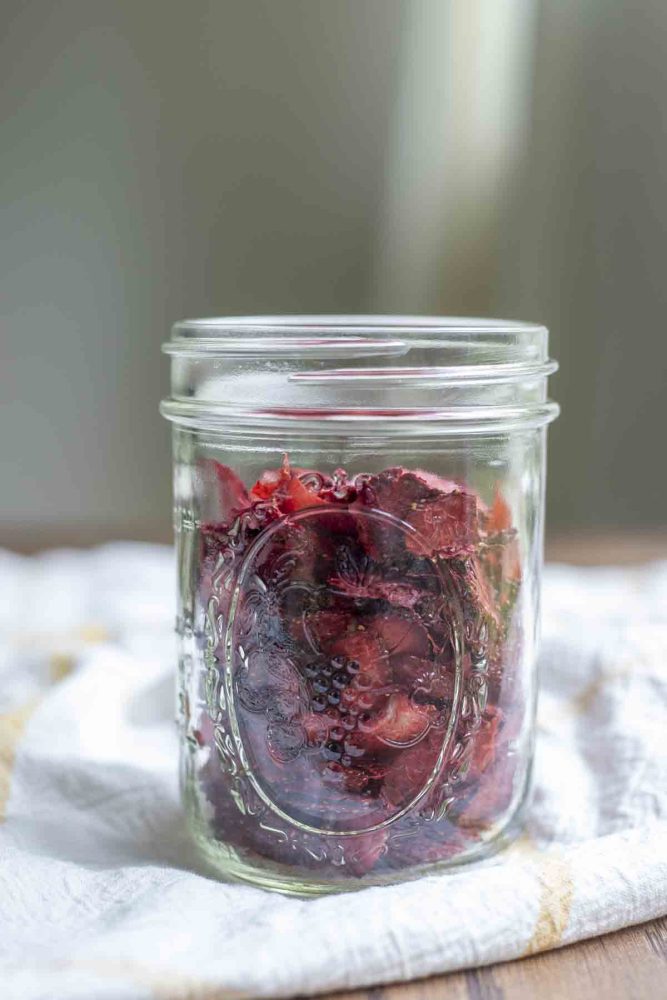
Tips:
- Make sure to wash and dry the berries thoroughly before beginning the process. Any excess moisture can slow down the drying time and even cause spoilage.
- Cut the strawberry slices to promote consistency in the drying time. Cutting them too thin can lead to over-drying and a loss of flavor, while cutting them too thick can result in uneven drying and a chewy texture.
- It’s also important to not overcrowd the dehydrator trays. Leave enough space between the slices to allow for proper air circulation and even drying.
- Keep an eye on the drying time and temperature. While it can vary depending on the dehydrator model and the size of the berries, a general guideline is to dry them at around 135°F for 6-12 hours. Checking the berries regularly during the process will help prevent over-drying and ensure a perfect end result.
- You can dry strawberries in a dehydrator or the oven.
The links in this post contain affiliate links and I will receive a small commission if you make a purchase after clicking on my link. See the full disclosure here.
Tools you may need:
Sharp knife: A dull knife makes it harder to slice the strawberries evenly and can result in some pieces being too thin and others too thick. A sharp knife not only makes the process easier but also ensures the berries dry evenly.
Cutting board: – Cutting on a clean, flat surface ensures that your strawberries slice evenly, and there is less risk of contamination.
Food dehydrator: There are many types of dehydrators on the market, including stackable ones with trays and more complex ones with multiple settings. Choosing the right dehydrator is important and will be covered in the next section, but you should make sure you have one that fits your needs before you start dehydrating.
Air-tight storage: Glass jars with tight-fitting lids or plastic bags with zip closures work well. I usually use a mason jar. Glass jars are a better options as plastic bags can let in oxygen which decreases storage time.
Baking sheets: If you are going to go the oven-dried strawberries route. You will need some baking sheets and parchment paper.
Choosing a Dehydrator
When it comes to dehydrating strawberries, having a the right dehydrator for you is key to making the process easy and efficient (although you can do this in the oven as well. See below).
There are many factors to consider when choosing the right dehydrator for you, such as size, price, and features.
First, consider how many strawberries you want to dehydrate at once. If you plan to dehydrate large batches regularly, a larger dehydrator may be more practical. However, if you only plan to only do small amounts for occasional use, a smaller dehydrator may suffice.
Price is also a factor to consider. Dehydrators can range from under $50 to over $300, with more expensive models typically having more features and higher quality. Determine your budget and look for one that suits your needs within that range.
Finally, consider the featuress. Some models offer adjustable temperature settings and timers, while others may have multiple trays for dehydrating different types of food simultaneously. Do your research and determine which features are most important to you.
Personally, it was really important to have a completely stainless steel dehydrator. Some contain plastic, and heating plastic can leach out chemicals (like BPA) into the food. So sticking with stainless avoids this.
Selecting the Right Berries
The success of your dried strawberries ultimately depends on the quality of the berries you choose. When selecting strawberries, it’s important to choose berries that are ripe and have a deep red color without any signs of mold or bruising.
The berries should be firm to the touch but not too hard, as overripe berries won’t be as yummy.
The best strawberries are those that are fresh and have been recently picked, ideally from a local farmer’s market or your own garden. If you’re buying strawberries from the grocery store, choose organic strawberries or “locally grown”, as these tend to be fresher and of higher quality.
Strawberries tend to be one of the most sprayed crops and since you are eating the skin, it’s preferred to choose “no spray” or organic.

Save This Recipe
How To Dehydrate Strawberries

Wash the berries under cold water to remove any dirt or debris. Be gentle when washing the strawberries to avoid damaging their delicate flesh. I like to place them in a bowl with cool water, and add some vinegar. Let them soak for about 5 minutes. Drain and rinse with cold running water.
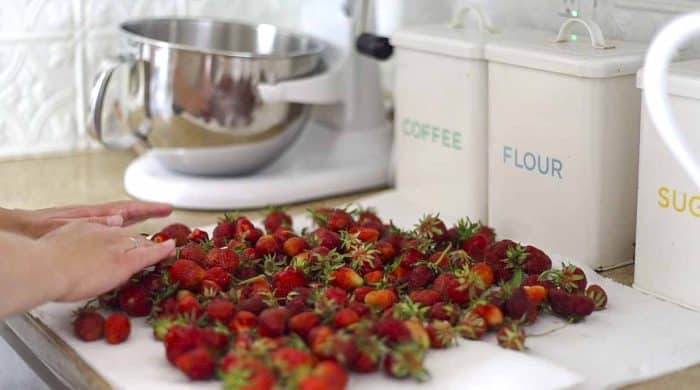
Use a clean towel to pat the berries dry or lay them out on a towel and allow to air dry. The latter is my preferred way. Any excess moisture can lead to uneven drying and spoilage.
Remove the green leafy top from the berries. This can be done by using a sharp knife or simply pulling the stems off with your fingers.
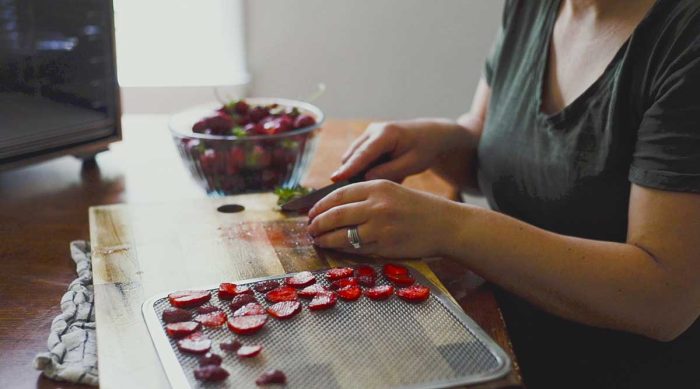
Using a sharp knife, slice strawberries in uniform slices roughly 1/8 inch thick. Cutting them too thin will leave you with strawberries that are hard to remove from the dehydrator (ask me how I know).

Next, arrange the fruit slices on your dehydrator trays, making sure to space them out evenly. For best results, avoid overcrowding. As this can lead to uneven dehydration and spoilage.
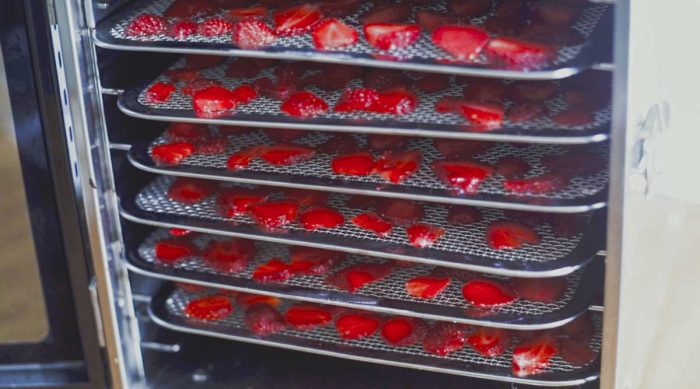
Set the dehydrator to the appropriate temperature to 135 °F and timer settings to 6 hours, and let it do its job. Depending on the temperature and humidity in your environment, it may take anywhere from 6 to 12 hours to fully dehydrate the strawberries.
Total time is determined by the temperature and thickness of the slices. Thicker slices will take longer.
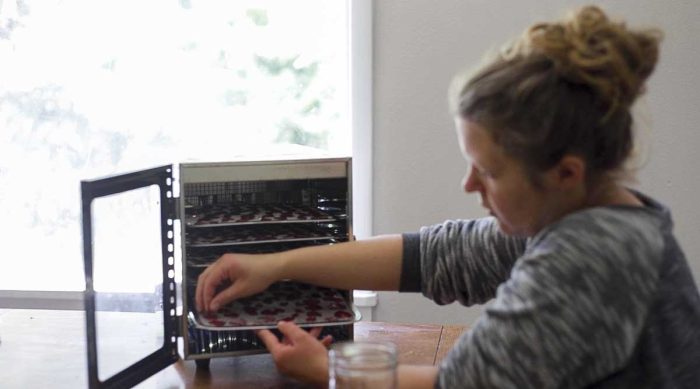
Once the strawberries are fully dried, carefully remove them from the trays and store them in an airtight container. This will help to preserve their freshness and prevent them from absorbing any moisture from the surrounding air.
Oven Method
Wash strawberries as directed above, use a clean towel to pat the berries dry or lay them out on a towel and allow to air dry.
Remove the green leafy top from the berries. This can be done by using a sharp knife, using a strawberry huller, or simply pulling the stems off with your fingers.
Using a sharp knife, slice strawberries in uniform slices.
Next, arrange the fruit slices on parchment lined baking sheets, making sure to space them out evenly. Avoid overcrowding.
Place them in an oven set at the lowest temperature setting. This could be 150-200 °F.
Bake for about 2 hours.
Flip and continue drying all the way through. This may take 30 minutes to another 2 hours depending on thickness and temperature.
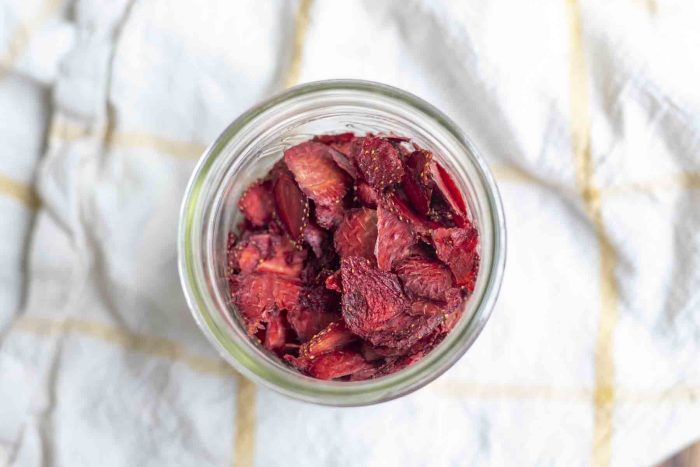
Storage
Make sure to label your packaging with the date you dehydrated the strawberries, as they will only last for several months once dehydrated.
To ensure dehydrated food maintains its quality over time, proper storage is crucial. Make sure the container is clean and completely dry, as any remaining moisture or bacteria can cause the strawberries to spoil.
For long-term storage, you may consider adding an oxygen absorber to the container. These packets will help reduce any remaining moisture or oxygen inside the container, preventing spoilage and extending the shelf life.
Store in a cool, dry place away from direct sunlight or heat sources. A pantry or cupboard is a great option, as long as it’s not too humid.
If you live in a particularly humid environment, you may want to store the container in the fridge or freezer to prevent any moisture from building up.
How To Use Dehydrated Strawberries:
- Eat as a delicious snack
- Add to trail mixes
- Turn into strawberry powder. Once dry, add to a food processor or blender and blend until a fine powder is created. Use it in yogurt, to color frosting and more.
- Great topping for ice cream
- Add to oatmeal
- Add on top of salad
- Add to quick breads and muffins

FAQ
If stored properly in an airtight container, dehydrated strawberries can last up to a year.
Yes! Frozen strawberries work just as well as fresh ones for dehydrating.
Dehydrated strawberries make a great snack on their own, or can be used in a variety of recipes like trail mix, granola bars, or baked goods.
Yes! You can use an oven set to a low temperature, around 150-200 °F, to dehydrate strawberries. Spread the sliced strawberries on a baking sheet and bake for several hours, flipping occasionally, until they’re dried out.
Almost any fruit can be dehydrated! Some popular choices include apples, bananas, and mangoes. Some are more challenging and take a longer amount of time, like blueberries.
No pretreatment is required besides washing and drying.
This depends on the thickness of the strawberries and the dehydration method. It can take anywhere from 2-12 hours.
Find More Ways To Preserve The Harvest:
- How To Freeze Strawberries
- Homemade Refrigerator Dill Pickles
- How To Freeze Tomatoes – Preserving Tomatoes Without Canning
- How to Freeze Kale – 2 Easy Ways
- Blueberry Chia Jam
Tried this recipe and loved it? I would love if you would come back and give it 5 stars. Please and thank you! Tag me on Instagram @ablossominglife

Dehydrated Strawberries
Save This Recipe
Equipment
- Dehydrator or oven
Ingredients
- 3 lbs Strawberries
Instructions
- Wash the berries under cold water to remove any dirt or debris. I like to place them in a bowl with cool water, and add some vinegar. Let them soak for about 5 minutes or so. Drain and rinse with cold running water.
- Use a clean towel to pat the berries dry or lay them out on a towel and allow to air dry completely.
- Remove the green leafy top from the berries. This can be done by using a sharp knife or simply pulling the stems off with your fingers.
- Using a sharp knife, slice strawberries in uniform slices roughly 1/8 inch thick. Cutting them too thin will leave you with strawberries that are hard to remove from the dehydrator.
- Next, arrange the fruit slices on your dehydrator trays, making sure to space them out evenly. For best results, avoid overcrowding. As this can lead to uneven dehydration and spoilage.
- Set the dehydrator to the appropriate temperature to 135 degrees F and timer settings to 6 hours, and let it do its job.. Depending on the temperature and humidity in your environment, it may take anywhere from 6 to 12 hours to fully dehydrate the strawberries. Total time is determined by the temperature and thickness of the slices. Thicker slices will take longer.
- Once the strawberries are fully dried, carefully remove them from the trays and store them in an airtight container. This will help to preserve their freshness and prevent them from absorbing any moisture from the surrounding air.
Notes
- Make sure to wash and dry the berries thoroughly before beginning the process. Any excess moisture can slow down the drying time and even cause spoilage.
- Cut the strawberry slices to promote consistency in the drying time. Cutting them too thin can lead to over-drying and a loss of flavor, while cutting them too thick can result in uneven drying and a chewy texture.
- It’s also important to not overcrowd the dehydrator trays. Leave enough space between the slices to allow for proper air circulation and even drying.

